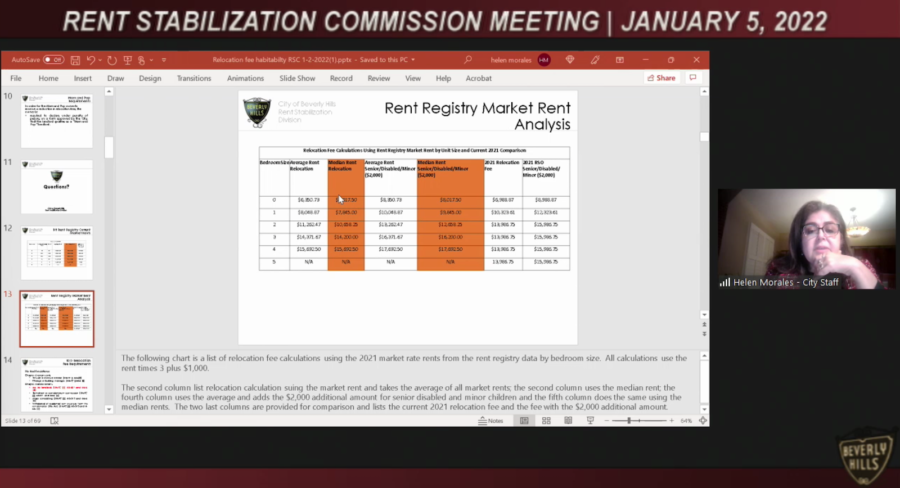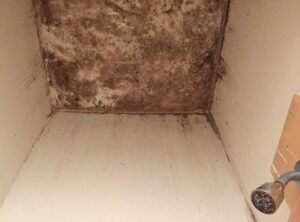RSO Commission OKs Fees, Whiffs on Habitability
The Rent Stabilization Commission has agreed to recommend to City Council that relocation fees should be calculated differently. Most households would receive a substantially reduced fee according to our analysis. Households that rent from a ‘mom-and-pop’ landlord owning four or fewer units could see their fee further reduced. The good news is that the commission came to loggerheads on habitability so no action was taken that would tank a better standard for conditions in Beverly Hills rental housing.
Relocation Fees
The Rent Stabilization Commission has adopted a final resolution to formally recommend to City Council that Beverly Hills change the way relocation fees are calculated. The current relocation fee schedule was established in 2017 and has been subsequently adjusted each year for inflation. The new fee formula recommended by the commission changes it up with a formula that recalculates the fee each year according to a ‘median monthly rent’ for an apartment of the same number of bedrooms as determined by the rent stabilization division. The fee adds $1,000 for moving expenses.
The relocation fee is intended to assist a household that is evicted for no-fault due to redevelopment (or other landlord uses of the property). In the context of multi-million dollar redevelopment the relocation fee is hardly even a rounding error. In any case for now no-fault evictions are paused at least until April 1st or at such a time as City Council ends the local moratorium.
The upshot of the commission’s action for tenants is that rent-stabilized households evicted would likely receive a substantially reduced fee compared to the current fee. Most of the reduction owes to the ‘median monthly rent’ figures used to calculate the fee. Our analysis shows that the resulting relocation fee would underestimate the actual cost of rental housing in Beverly Hills today. That would put relocating households at a financial disadvantage.

The relocation fee also disadvantages most evicted households because the compensation for the local moving expense is too low. As recommended by the commission an evicted household would receive a flat $1,000 for moving regardless of apartment size (clearly too little for a larger apartment). As our analysis shows, dollar-for-dollar the recommended compensation effectively amounts to two-thirds of today’s compensation.
We called this a bad deal for tenants because as many as 9-in–10 households would receive a much lower fee (compared to the current fee) if those fees took effect today.
Finally, the commission recommended a mom-and-pop fee reduction. If a household is renting from a landlord that owns 4 or fewer rental units in the city, the relocation fee can be reduced further by 25% (or 15% if the household has been renting the apartment for a decade or more). We estimate that as many as 1-in–7 households could see their relocation reduced further under this provision.
These recommended changes advantage the landlord at the expense of tenants. Tenant commissioners voiced concern about the paltry moving compensation in December but their concerns were brushed aside by the other commissioners. As the commission prepared to vote on the final recommendation resolution at the January meeting, tenant commissioners again raised concern and asked to reopen the discussion. Again those concerns were brushed aside.
The Rent Stabilization Commission adopted the resolution by a vote of 4–2: landlord and at-large commissioners supported it with both tenant commissioners opposed. The commission’s recommendation will next go to City Council. If Council agrees then new fees could take effect as soon as July. Watch the video of the commission’s relocation fee discussion.
Habitability
The habitability issue returned for a third time to the Rent Stabilization Commission in January. The problem is straightforward: tenants have consistently stated that housing conditions are sometimes not satisfactory. But the current complaint-driven code enforcement process puts the tenant in the position of an amateur housing inspector. That means tenants must report the landlord for a potential violation but without the protection of a badge (or a salary).
We are talking here about two kinds of habitability problems: 1) instances where the premises fails to meet the state’s low standard for ‘tenantable’ (i.e., fit for human habitation); or more commonly 2) the landlord fails to maintain the property inside and/or out.

Due to the inaction of a minority of Beverly Hill landlords, a small but not insignificant segment of our Beverly Hills rental housing stock has been allowed to fall into dilapidation. City hall has acknowledged the problem. Fifteen years ago city building officials proposed a systematic rental housing inspection program to proactively identify substandard conditions in rental housing and thereby take tenants out of the complaint process.
In 2018 City Council indicated support for a higher local habitability standard and began to discuss an inspection program. Both were sent to the Rent Stabilization Commission agenda for more discussion. That is easier said than done! An earlier commission discussion had broken down along partisan lines: tenant commissioners expressed concern about housing conditions such as old paint, worn floor coverings and appliances not kept in repair, and suggested the value of a local habitability standard. Landlord commissioners however weren’t interested in a new local habitability standard.
In this January discussion it was clear that landlord commissioners wouldn’t be yielding. Commissioner Baseman thought habitability was a non-issue. “Based on numbers [of complaints] it doesn’t seem there’s a habitability issue in this city,” he said. But tenant commissioner Bronte disagreed. “I know personally that a lot of people call about habitability” and added that she had her own unsatisfactory experiences concerning habitability.
To move the discussion along, Chair Donna Tryfman (who is an ‘at-large’ or neutral commissioner) suggested putting the question about a habitability standard on the back burner to instead focus on the other discussion questions posed by the staff report:
- Whether to establish a proactive City inspection process in addition to the existing complaint-based process;
- Whether to restrict the annual rent increase or even mandate a rent reduction for properties with ongoing or unaddressed habitability violations; and,
- Whether to have the Commission act as an administrative hearing board to determine habitability violations.
On adjudicating habitability disputes there was initial consensus: tenants could bring habitability complaints to the Rent Stabilization Commission for adjudication in some kind of a hearing. But that agreement foundered on whether commissioners would be prepared to judge a violation; and whether the commission could substantiate a violation without actually visiting the property to judge it.
With more details to work out the commission voted 5–1 to take on the responsibility with one landlord commissioner dissenting.
The question about a city housing inspection program proved more challenging. Rental housing is not inspected by the city unless a complaint is filed. Mindful of landlord skepticism about the problem, tenant commissioner Kandace Lindsey-Cerqueira suggested “a baseline inspection to determine the magnitude of the habitability issues.” Once a baseline is established with an inspection, she said, “We could revisit it every five years.”
Landlord commissioner Neal Baseman disagreed. “There is no need to proactively look for habitability issues when the complaint system seems to be working,” he said. He warned against “more people hired, more bureaucracy.” He also suggested that tenants were using the habitability issue to wrangle better amenities from a landlord. “Habitability is a base standard in which people have the ability to live within the unit,” he said — “not a way to get better, newer cleaner, whatever. As long as they have running water, sewage — that’s what habitability is.”
Tenant alternate commissioner Lindsey-Cerqueira replied, “Obviously there is a habitability issue or we wouldn’t be discussing it.”
Landlord commissioner Frances Miller instead proposed fines for tenants who “create” habitability problems. “There is a pattern here of vilifying the landlords, like we have to punitize [sic] the landlords and put everything on the landlord — like the landlord is nefarious and evil,” she said. Landlord commissioner Baseman suggested a rent increase for tenants that cause habitability issues. In one of the few instances of rent stabilization division staff correcting the discussion, deputy director Morales reminded commissioners that such an increase would run afoul of the law.
Should the city retail the complaint-driven system we have today? Landlord commissioners didn’t see a problem and wanted to keep it. So did at-large commissioners Lou Milkowski and commission chair Donna Tryfman. Tenant commissioners wanted to discuss it further.
In the end our commissioners could only agree (by a 5-1 vote) to bring habitability complaints to the commission. The questions about the habitability standard, inspections and possible enforcement penalties were continued to the next meeting on February 2nd. Watch the commission video for the whole picture.
Our Take on the Commission’s January Discussion
The current complaint-based system works fine as long as a landlord properly maintains the property and premises and there is no cause for complaint. But when maintenance is deferred or a landlord neglects to make needed repairs, the current system fails tenants. It is difficult to hold a landlord accountable when there is no effective combination of habitability standard and enforcement regime.
We do know habitability troubles tenants: they call the rent stabilization division; they file code complaints; they tell City Council that landlords fail to maintain and they express concern about retaliation for reporting a problem to the city. Unfortunately our commissioners didn’t see any support for tenant claims because the rent stabilization division did not produce a representative selection of cases filed or images that were submitted by tenants. Last year the rent stabilization division received more than 600 habitability-related calls from tenants. What were those tenants calling about? The commission wasn’t informed.
Without a clear presentation of the habitability issue both tenant and landlord commissioners could talk past each other. And predictably that is exactly what happened at this meeting. Landlord commissioners simply sidestepped the whole issue. “There is no need to proactively look for habitability issues when the complaint system seems to be working,” said landlord commissioner Neal Baseman. “Based on numbers it doesn’t seem there’s a habitability issue in this city.”
Of course the problem is plain to see from a walk down a multifamily block. That’s why Renters Alliance supports a local habitability standard with specific penalties and a system of proactive housing inspections so that tenants are not on the hook to rat on landlords. (Read the Renters Alliance comment about relocation fees and habitability.)
We are not asking the Rent Stabilization Commission to solve an intractable problem. This is not rocket science. Indeed there exist models to emulate.
City of Los Angeles inspects rental properties every three or four years. These aren’t surprise ‘gotcha’ inspections like restaurant inspections; they are noticed well in advance because the objective is to encourage compliance without having to resort to penalties or prosecution. Santa Monica aggressively enforces against violations. The city prosecutor regularly hauls landlords to court (which doesn’t happen in Beverly Hills). West Hollywood notably adopted a local habitability standard that requires repainting and replacement of floor coverings on a regular schedule. Landlords that fail to meet the obligation can be docked with a rent reduction.
It is simply a matter of standards and enforcement. Is that too much to ask of this commission? However if this meeting is any indication we can expect further commission dysfunction to hobble the search for a solution to the city’s well-documented habitability problems.
Have a look at 421 South Maple which was for rent last year for $2,495. It is a one-bedroom unit that exhibited many of the habitability deficiencies about which tenants often complain. No household paying rent in Beverly Hills should have to live with such conditions.










